Millets Benefits, Qualities, Varieties, Research, Recipes
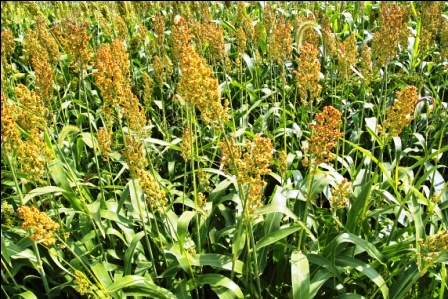
By Dr Renita D’Souza
Millets are small seeded gluten-free cereal. Its high protein content makes it a good energy booster. They are good source of antioxidant and improve digestive health, respiratory functions, detoxifies the body, improves immunity, prevents degenerative diseases like Parkinson’s diseases, diabetes, cardiac disease, cancer etc
Read – Barley (Hordeum vulgare) – Qualities, Uses, Remedies, Research

Table of Contents
Introduction
A research study have mentioned that consuming millet grains (kodo millet) 6 times every week is considered as wholesome diet for postmenopausal women with high cholesterol, blood pressure or cardiovascular disease. (read related)
In some parts of Asia and Africa, they use millet as main food component. It is also used to prepare beverages, bread, porridge and snack foods. Millet is an alkaline forming food and balances the pH of the body.
Millets are often referred to as ‘coarse grain’ or ‘poor people’s crops’. They are cultivated all over the world. They are small seeded, round in shape. They are cultivated in less fertile soil, require less water and resistant to pests and diseases.
Read – Chickpea (Bengal gram) – Qualities, Uses, Remedies, Types, Research
Benefits of Millets
- Diabetes – The magnesium content in millets helps to promote healthy blood sugar level (read related)
- Cardiovascular diseases – Millets reduces the cholesterol level and prevents cardiovascular diseases. The magnesium content in millets reduces the frequency and effects of migraine and heart attack.
- Obesity – The studies show that consuming high dietary fibre food prevents incidence of obesity. The Vitamin B3 content of millet helps to reduce cholesterol level.
- Celiac disease – Millets are gluten free and hence used in patients suffering from gluten-sensitive enteropathy
- Cancer – The phenolics content in millets helps to prevent the risk cancer. (read more)
- Inflammation – Millets are good source of antioxidant and thus stimulate wound healing, prevents tissue damage and pre-aging symptoms.
- Prevent Gall stones – The insoluble fiber content of millet helps to prevent gall stones (read more)
- Gastric Ulcers – Its anti acidic property and high fibre content reduces the risk of gastric ulcers and relieves constipation.
- Childhood Asthma – consuming millet reduces the risk of childhood asthma by about 50%.
- Hypothyroidism:
Millets are good to keep the obesity under check, which is seen often associated with hypothyroidism. But there is some argument that millets may contain cruciferous vegetable particles, which then can restrict iodine absorption. But this claim is over-exaggerated and does not hold much ground. Even if that is the case, then you can include foods that are rich in iodine in your diet – iodized salt, seaweed, cheese, milk, corn, boiled eggs, yogurt, banana etc.
Millets have lower glycemic index than rice. So, millets can help you with reducing the chances of diabetes, which is often associated with the risk of hypothyroidism.
Read related: Hypothyroidism Causes, Symptoms, Ayurvedic Treatment, Remedies
Can millets be taken during hypothyroidism?
Medicinal Qualities
Millets – Trinadhanya
In Ayurveda, millets belong to the group of Trina dhanya varga (group of grains produced by grass like plants)
Synonyms
Trinadhanya, Shudra dhanya, Kudhanya
Qualities
Taste – sweet, astringent
Vipaka (taste conversion after digestion) – pungent (katu)
Virya (potency) – slightly hot (kinchith ushna)
Ruksha – dry in nature
Kleda shoshakam – dries up excess body moistness
Badda vitkam – constipating in nature
Avrishyam – non aphrodisiac
Effect on Tridosha –
Vatakrth – increases vata dosha
Pitta rakta kaphaapaham – Balances pitta, kapha dosha and blood tissue
Read – Ayurveda Mahodadhi Dhanya Varga – Types Of Rice
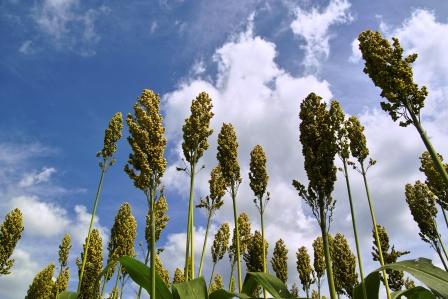
Cooked Millets Uses
Trina dhanoudana, Uses
Well cooked millets are light to digest, appetizing and carminative in nature. Excess intake can increases vata dosha.
Uses –
Breathlessness
Splenic disorders
Liver disorders
Gudagata vikaras like haemorroids, fissure, fistula etc.
Read – Rice Combinations With Pulses, Vegetables, Grains, Soups
Nutritional Values
Nutritional Value of Millets
Millets contain carbohydrates – 60-70%, proteins – 7-11%, fat – 1.5-5%, crude fiber 2-7%. They are good source calcium, magnesium, potassium, manganese, phosphorus, iron, polyphenols and protein.
Millet Recipes
Different recipes are prepared from millets.
Appalu – It is a crispy snack prepared from pearl millet and bengal gram.
Samaipayasam – It is a sweet (kheer) preparation.
Korramurukulu – It is crispy savoury snack, prepared from foxtail millet and bengal gram flour. (read more here)
Beverages
Sur – It is a finger millet based fermented beverage.
Madua – Finger-millet-based beverage prepared in Arunachal Pradesh.
Oshikundu – It is prepared by fermenting pearl millet meal (mahangu), malted sorghum, bran and water
Koozh – It is prepared by fermenting millet flour and rice
Read – Ayurvedic Wheat Noodles: How To Make? Benefits
Wrong food Combination
- Consuming chinaka (Proso millet) and other grains along with milk, curd, buttermilk, oil etc can cause ekakushta (psoriasis) read related
- Kangu (Foxtail millet) along with milk are mutually contradictory. (read)
Indigestion by Millets
Indigestion caused by kangu (Foxtail millet) is treated by Mantha (churned curd/supernatant of buttermilk)
Read – 120 Remedies For Indigestion Caused By Specific Foods
Varieties, Phytochemicals
Phytochemicals
Millet contains phenolics, lignans, β-glucan, inulin, resistant starch, phytates, sterols, tocopherol, dietary fiber and carotenoids.
Varieties of Millets
Pearl millet – Pennisetum glaucum ( Sajjai, Bajra)
Finger millet – Eleusine coracana (Ragi, Mandua)
Kodo millet – Paspalum setaceum (Harka, Kodon)
Proso millet – Penicum miliaceum (Baragu, Barre)
Foxtail millet – Setaria italic (Navane, Kangni)
Little millet – Panicum sumatrense (Same, Kutki)
Barnyard millet – Echinochloa utilis (Oodalu, Sanwa)
Sorghum – Sorghum spp.
Guinea millet – Brachiaria deflexa
Browntop millet – Urochloa ramose
Teff – Eragrostis tef
Fonio – Digitaria exilis
Job’s tears – Coix lacrima-jobi
Read – Adlay millet Coix lacryma-jobi: Benefits, Research, Remedies
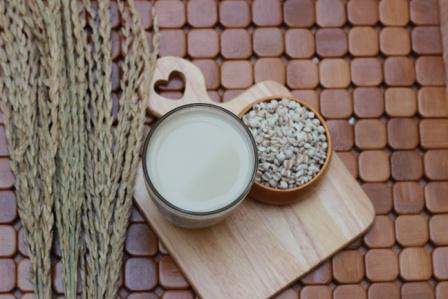
Sanskrit Verses
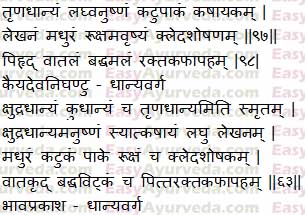
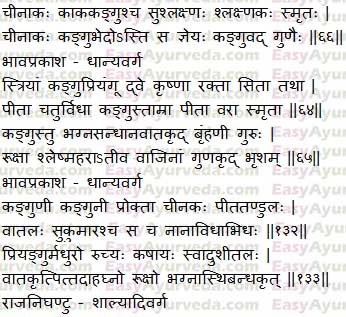
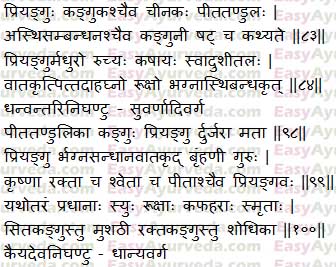
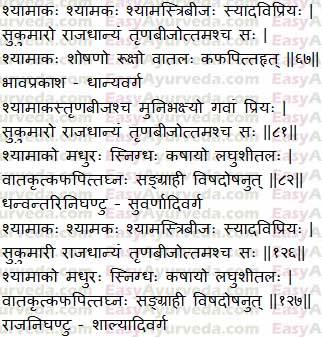
Interaction with medicines, supplements
Can this be used while taking Homeopathic medicine?
Yes. This product does not react with homeopathic medicine.
Can
this medicine be continued while taking supplements like multivitamin tablets,
Omega 3 fatty acids etc?
Yes. Generally, this product goes well with most
of the dietary supplements. However, if you are taking more than one product
per day, please consult your doctor for an opinion.
With western
medicines
Seek your
doctor’s advice if you are taking this product along with other western
(allopathic / modern) medicines. Some Ayurvedic herbs can interact with modern
medicine.
If both Ayurvedic and allopathic medicines are advised together, then it is
best to take Allopathic medicine first, wait for 30 minutes and then take the
Ayurvedic medicine.
Finger millet – Ragi Benefits
Botanical Name – Eleusine coracana
Vernacular names
Hindi Name – Ragi, Marwah, Mandika
Bengali Name – Marwa
Gujarati Name – Nagli, Bavto
Kannada Name – Ragi
Marathi Name – Nagli, Nachni
Punjabi Name – Mandhal, Mandhuka
Tamil Name – Ragi, Keppai, Kelvaragu
Telugu Name – Ragi codhi
Read – Wheat Uses, Health Benefits, Side Effects: Complete Ayurveda Details
Uses
- Ragi is a good source of natural calcium and iron.
- It strengthens the bone and prevents fractures.
- It is a good diet for diabetic patients because of slow release of sugars in blood.
- Due to its high fiber content it reduces the cholesterol level, relieves constipation, bloating, flatulence and prevents colon cancer.
- It is a nutritious food, rich in calcium, proteins, aminoacids, minerals and vitamins, hence considered as beneficial diet for infants, aged and pregnant women.
- It improves the breast milk production.
- It is used in anemia, prevents malnutrition and degenerative diseases. It increases the hemoglobin level. (read)
Finger millet Wine
The wine prepared finger millet (Madhulika) is heavy to digest (guru), causes bloating and aggravates Kapha dosha. This reference is found in Charaka Samhitha Sutrasthana 27th chapter.
Chinaka (Proso millet)
Proso millet is a nutritious gluten free crop and a good source of energy. Studies show that proso millet contains high iron and protein content than wheat or rice (a)
In Ayurveda, it is known by the name Chinaka. It is considered as a variety of kangu and possess similar quality. Proso millet is one of the commonly cultivated millet.
Botanical Name – Panicum miliaceum
Family – Gramineae
Uses
- Proso millet has high content of Vitamin B3 (niacin) and hence used in Pellagra, a condition characterized by dementia, diarrhea and dermatitis caused by deficiency of Vitamin B3.
- Traditionally it is consumed while recovering from illness and post pregnancy.
- The husked proso millet grains are cooked like rice, gruel or eaten whole.
- They are also made in to flat bread (roti).
- Used to make Tabbouleh (Mediterranean salad) and fermented beverages (A).
- Proso millet is used as birds feed and as livestock feed in developed countries.
Read – Green Gram (Mung bean) Qualities, Uses, Remedies, Research
Vernacular Name
English Name – Indian millet, Brown-corn millet, Common millet, French millet, Grand millet, Millet panic (grass), Proso millet, Russian millet, Hog Millet, Broomcorn millet, Red millet
Hindi Name – Chena, Chinna, Chaina
Bengali Name – Cheena
Marathi Name – Varivava, vari
Gujarati Name – Chine, China, Cheno
Kannada Name – Baragu
Tamil Name – Panivaragu
Telugu Name – Varigalu, Variga
Punjabi Name – Cheena
Odia – china bachari bagmu
Spanish Name – mijo comun
French Name – millet commun, millet des oiseaux
Germany – Echte Hirse, Echte Rispenhirse, Rispen- Hirse
Italy – miglio nostrale
Controversy
The word ‘Chinaka’ is also considered as a variety of camphor (karpura) and known to be as artificial camphor.
Sanskrit Synonyms
Chinaka, Kakakangu, Sushlakshna,
Shlakshnaka
Morphology, Distribution
Morphology
Proso millet are small seeded annual crop. It grows up to 30 to 100 cm tall.
Leaves are alternately arranged, linear and slender covered with fine hairs. Seeds are 3 mm long, 2 mm wide and oval in shape. They are enclosed in a smooth husk which can be white, yellow, red and can also be in gray, brown or black colour. This crop matures in 50 – 90 days and does not require more water. Roots are fibrous and shallow.
Distribution
Proso millet is cultivated in China, India, Nepal, Russia, Ukraine, Belarus, the Middle East, Turkey, Romania and the United States.
Classical Categorization
Bhavaprakasha Nighantu – Dhanya varga
Kaiyadeva Nighantu – Dhanya varga
Read – Importance Of Diet (Pathya) For Specific Diseases
Kangu (Foxtail millet)
Botanical Name – Setaria italica
Family – Gramineae
Foxtail millet (kangu) is a good source of magnesium. It is good for heart and prevent diabetes.
Vernacular Names
Sanskrit Name – Kangu
English Name – Foxtail millet
Hindi Name – Kanguni, Kagani, Tanguni
Bengali Name – Kanguni
Marathi Name – Kang, rala
Telugu Name – Koralu, Korra
Tamil Name – Thinai, Kavalai, Kambankorai, Nuvanam (millet flour)
Gujarati Name – Kanga
Kannada Name – Navane, Navanakki
Punjabi Name – Kangni
Malayalam Name – Thina
Nepali Name – Kaguno
Medicinal Qualities of Kangu
Taste – sweet, astringent
Ruksha – dry in nature
Guru – heavy to digest
Ruchya – improves taste
Virya (potency) – cold
Bhagna sandhana – heals fracture
Brumani – nourishes
Dahagna – relieves burning sensation
Vaajinam – good for horses
Effect on Tridoshas
Decreases kapha dosha
Increases vata dosha
Read – Bad Food Combinations And Solution As Per Ayurveda
According to Nighantu as mentioned in Bhojana Kutuhalam, Kangu promotes union of broken body parts, aggravates vata, nourishes the body. It is heavy and dry, alleviates kapha and is especially healthy for horses.
Sanskrit synonyms
Kangu, Priyangu, Pitatandula, chinaka
Varieties of Kangu
1. Black (krishna) variety
2. Red (laal) variety
3. White (sitha) variety
4. Yellow (pitha) variety
Yellow variety is considered to be the best.
Classical categorization
Bhavaprakasha Nighantu – Dhanya varga
Raja Nighantu – Shalyadi varga
Dhanvantari Nighantu – Suvarnadi varga
Kaiyadeva Nighantu – Dhanya varga
Shodala Nighantu – Trinadhanya varga
Controversy
Priyangu (Callicarpa macrophylla) is a different herb which has Kangu and Kanguni as its synonyms.
Read – Priyangu Callicarpa macrophylla: Uses, Research, Remedies
Shyamaka (Barnyard millet)
Botanical Name – Echinochloa esculenta
Synonym – Echinochloa utilis
Family – Gramineae
Vernacular Name
Sanskrit Name – Shyamaka
Hindi Name – Sawa, Sav
Bengali Name – Sawa, Shamula, Shyamadhana
Marathi Name – Jangali sama, Samula, Bhagar
Kannada Name – Samai, Savai, Oodalu
Gujarati Name – Samo, Samoghasa
Telugu Name – Odulu
Tamil Name – Kudraivali pillu, Kuthirai Vaali
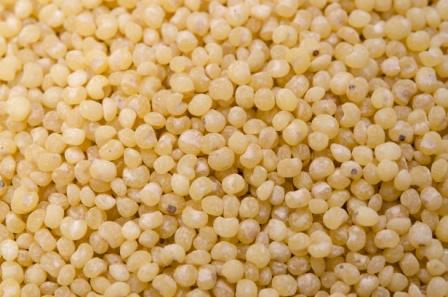
Medicinal Qualities, Uses
Taste – sweet, astringent (kashaya)
Laghu – light to digest
Ruksha – dry in nature
Snigdha – unctuous (according to Dhanvantari and Raja Nighantu)
Shoshana – causes depletion of tissues
Potency (virya) – cold
Sangraahi – absorbent in nature
Visha doshanuth – used in poisoning and toxic conditions
Effect on Dosha
Increases vata
Balances kapha and pitta dosha
Read – Navara Rice (Shashtika Shali) Qualities, Uses, Remedies, Research
Uses
- Shyamaka is used as treatment for over nourishment i.e brimhana. (ref – A.H. Su 14)
- Traditionally it is considered as beneficial diet in diabetes (read)
- It is one of the best diet used in rheumatoid arthritis.(read)
Sanskrit Synonyms
Shyamaaka, Shyamaka, Shyama, Tribija, Avipriya, Sukumara, Rajadhanya, Trinabijothama.
Research
Antiproliferative activity – A study conducted on Phyotchemical content and antiproliferative activity of Proso millet have concluded significant cellular antioxidant and antiproliferative properties of proso millet. The phenolic acid content in Proso millet contributes to its anticancer activity. The study also showed that consumption of Proso millet improves general health.
Anti diabetic Activity – A study conducted to evaluate the effect of foxtail millet (Setaria Italica) based diet on blood sugar levels in type 2 diabetes. The result concluded that consumption of foxtail millet based diet for 30 days controls the blood glucose level.
Ayurvedic medicine
Ayurvedic Medicines with Millet as Ingredient
Sri Sri Tattva Ojasvita Ragi – Used as a daily herbal health drink for all age groups.
Classical Categorization
Bhavaprakasha Nighantu – Dhanya varga
Kaiyadeva Nighantu – Dhanya varga
Dhanvantari Nighantu – Suvarnaadi varga
Raja Nighantu – Shalyaadi varga
Shodala Nighantu – Trinadhanya varga
Click to Consult Dr Renita D’Souza
Opinion by Gary:
I think the best varieties of millet for general use are kodo and barnyard. Like barley and gavedhuka were once main grains, it seems those higher in fiber are more suited to the modern lifestyle. Finger, foxtail, and other varieties having become popular, I think it is because many used to be active, like farmers, and needed the energy (such as from rice or urad dal) for work. Most do not live that life anymore.











9 comments
Abhay
Vatakrth – increases vata dosha
Pitta rakta kaphaapaham – Balances pitta, kapha dosha and blood tissue.
Is it true for every Millet mentioned above?
Are all the Millets called kodon,(कोदों)?
What should be daily intake quantity per person?
Kindly Answer, Many Thanks ?
Dr J V Hebbar MD(Ayu)Author
Almost all millets can increase Vata and balance Pitta and Kapha.
All millets are not called kodon.
It can be used alone as staple food or 50% of it can be added with wheat to make Chapati, roti etc.
T Vijayalakshmi
I would like to include Ragi as part of my daily diet or any other millet. I am hypothyroid and anemic and underweight. How can I include millet in my diet without causing vata imbalance and weight loss. Instead of weight loss, I want to achieve weight gain. As wheat doesn’t suit me I have to depend only on rice so don’t get full range of nutrients in my diet. Please advice.
Dr J V Hebbar MD(Ayu)Author
Ragi Roti, Ragi Mudde, Ragi Dose, Ragi Ambali etc. can be made.
Vijayalakshmi
How to eat millet to gain weight and without causing vata imbalance. Adding milk to cooked Ragi powder, will it remove vata dosha.
For hypothyroid, which millet is good and how should it be eaten for weight gain and in what quantity.
Dr J V Hebbar MD(Ayu)Author
If you want to gain weight and improve body nutrition, then there is no big reason to include millets in your diet. Cereals such as rice, wheat etc. are more useful to gain weight. The premise of taking millets is to reduce the amount of nutrition that the body is getting without feeling hungry all the time.
Adding milk to cooked Ragi will reduce the Vata effect. Yes.
Ragi Roti (pancake) can also be prepared by adding a little sesame oil, which would reduce the Vata aggravation.
L Rao
Thanks for the article on millets. I have hypothyroidism and I was told not to eat millets. But i wanted to try. So while avoiding Finger MIllets, I started on Kodo, Little, Barnyard, Brown top and Foxtail (each on different days). After 4 months of use, I did not see any impact on my thyroid panel numbers (TSH etc.). So I figured it was safe. Weight is slightly down, but cholesterol numbers are still high. HbA1c is at 6.0 Am wondering whether to continue with millets or go back to brown rice. Thank you.
Dr J V Hebbar MD(Ayu)Author
Continuing millet is fine. Also, try to reduce the amount of total food intake by 20%.
Eating less is associated with reduced risk to diabetes, hypertension, cancer etc.
Sharon Dhindsa
Millet are beneficial for arthritis as it increases vata dosh. Every time I eat get acidity is it normal after consuming millets.